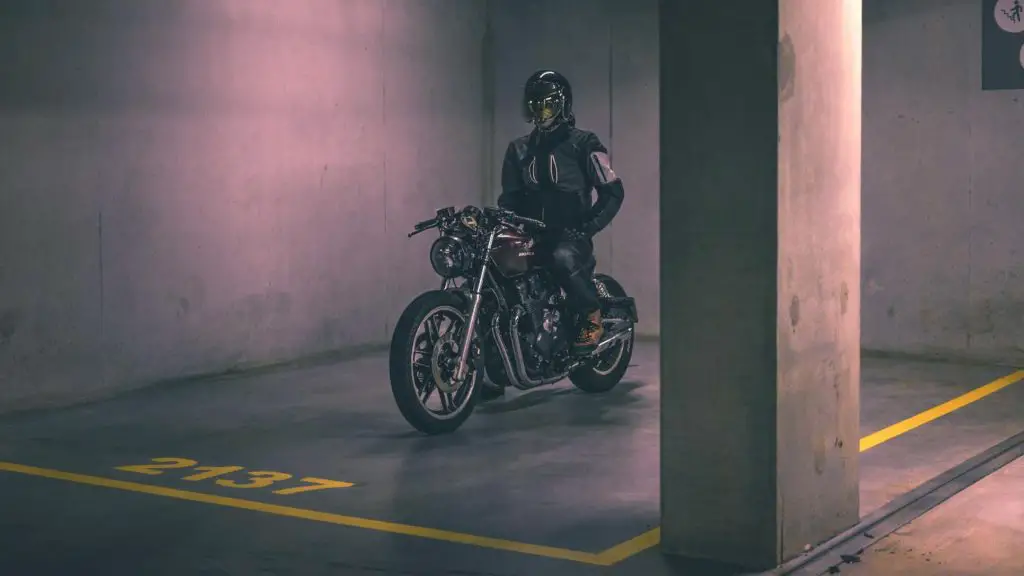The prudent motorcycle rider dresses for the slide, not for the ride. Bad weather, slick roads, other careless riders and drivers, a malfunctioning bike, or a momentary lapse of concentration on your part can cause you to lose control of your motorcycle. Can you prevent injuries if you wear motorcycle jeans, or are they even safe to wear while riding?
Motorcycle jeans are safe if they are specifically designed for riding and are reinforced with a sturdy material like Kevlar® or CovecTM. These jeans protect riders from abrasion from sliding. The safest jeans also have armors to protect the knees, shins, and hips from impact injuries.
In this article, I will describe the different fibers used to make motorcycle jeans and their pros and cons. I will also give you a few tips to help you buy a pair of jeans that is safe and comfortable.
What Are Motorcycle Jeans Made of?
Your motorcycle trousers should cushion you from injuries that can result from abrasion and impact. They should also protect you from the elements and be comfortable to wear on hot days.
Motorcycle jeans are made of a denim exterior shell lined or blended with an abrasion-resistant fabric like Kevlar®, CovecTM, Cordura, or reinforced nylon. More advanced designs of motorcycle jeans combine denim with Armalith® fabric to produce lightweight, abrasion-resistant riding gear.
Leather is one of the toughest and most abrasion-resistant materials around. At one time, motorcycle riders concerned about their safety wore leather motorcycle pants.
However, leather does not let your legs breathe and is suffocating to wear for long periods, especially on hot days. So, apparel manufacturers were forced to develop abrasion-resistant fabrics that are also comfortable to wear.
Read on to find out more about the fabrics that go into making a pair of motorcycle jeans.
Kevlar®
Kevlar® is used to make bullet-proof vests and stab-proof wear, and it is about five times stronger than steel when compared by weight and has a high melting point. Kevlar® is also puncture-resistant.
The original motorcycle jeans were made of denim lined with Kevlar® fabric.
In the event of a fall or a slide, the Kevlar® lining protects the rider from severe abrasion and impact injuries. The high melting point of the material also means that in a crash situation where friction produces high heat, the jeans do not melt. However, these jeans are heavy and have little breathability.
Apparel manufacturers then came up with the technology to weave denim and Kevlar® to create a single fabric.
The Kevlar® motorcycle jeans that you see in stores today are made from this blended fiber. Motorcycle jeans made from this fiber are lightweight but are less abrasion-resistant than the original Kevlar®-lined denim jeans.
Aramid
Kevlar® fabric is made up of “para-Aramid” fibers. Motorcycle jeans made of Aramid fiber are somewhat like Kevlar®. The yarn is blended into denim, creating a stronger pair of jeans that allows you to ride safer. Even if you have an accident, you should be better protected in jeans that have these fibers.
Armalith®
Aramid-lined denim jeans are uncomfortable to ride in on hot days. They heat the body and are heavy.
To counter this problem, Armalith® has combined denim fibers with UHMWPE (ultra-high-molecular-weight polyethylene) strands to develop a material that the company claims offers as much protection as leather does.
Cordura
The Cordura fabric contains nylon and is widely used as a tire liner in military vehicles.
According to some manufacturers, motorcycle jeans made of Cordura fabric are more resistant to tears, scruffs, and abrasion than Kevlar® jeans. The nylon in the Cordura adds elasticity to the trousers and keeps the wearer comfortable.
CovecTM
The CovecTM yarn has a high melting point and low thermal conductivity. The manufacturers of this yarn claim that motorcycle jeans made from this material prevent burn injuries that may result from a crash.
Materials like UHMWPE, nylon, and polyester have low melting points and high thermal conductivity. In the event of a crash where excessive friction produces heat, a rider wearing trousers made of these materials risks being burned to the skin.
Grit and glass pieces on the road can cut through the trouser fabric and cause severe tears and lacerations. CovecTM is cut-resistant, making any pair of jeans made from this yarn extremely safe.

Is Denim Abrasion-Resistant?
Denim is not abrasion-resistant. Although it is durable and rugged, denim trousers will rip within 2-3 seconds of a motorcycle rider hitting the asphalt and beginning to slide down the road.
Therefore, apparel manufacturers weave abrasion-resistant fibers into denim to make motorcycle jeans.
How To Buy Motorcycle Jeans
Motorcycle jeans are made from many different fabrics, each with its own set of pros and cons. However, there are other considerations to think about when it comes to buying a pair of motorcycle jeans that are safe and comfortable.
After you decide what fabric your jeans should be made of, consider the following factors.
Single-Layer vs. Lined
Motorcycle jeans can be 100% lined or less. Partly-lined jeans offer protection at the critical impact areas, such as the knees and the butt. The greater the percentage of lining, the more abrasion-resistant the trousers are.
However, a downside of 100% lined jeans is that they tend to be very heavy and are not breathable. They also hamper your ability to cool down.
Single-layer jeans are made from a single, sturdy material and usually offer more protection and greater comfort than lined jeans.
Armor
Any pair of safe motorcycle jeans must have armored protection at the hips, shins, and knees. Look for CE or EN-rated armor plates that offer the highest levels of abrasion resistance.
Some motorcycle jeans come with pockets for the armor plates. You can remove the plates when you are not riding. When buying motorcycle jeans, opt for a pair with armor plates with the trousers.
Some jeans require you to pull down the pants to put on or remove the armor plates. Other jeans have pockets on the outside to place the armors. These pockets are custom sewn so that the armor plates fit snugly and do not move, even on impact.
Fit
When you sit on the bike, your jeans ride up and expose some portion of your lower leg. So, your motorcycle jeans should be a tad too long when you stand in them.
The knee armor plates should sit right above the kneecap and a couple of inches above the knee. While trying out various brands at the store, ensure that you walk around in jeans. The legs should not be so wide that the armor plates move around.
Conclusion
The technology of making motorcycle jeans has come a long way. Expect more manufacturers to come up with jeans that offer greater protection and increased comfort.
Meanwhile, as you shop for a pair now, keep in mind the following points:
- Choose the material based on the degree of protection against abrasions, cuts, and scruffs.
- Look for the comfort factor.
- Choose a pair that covers your hips and legs entirely.
- Choose a pair with armor plates.
